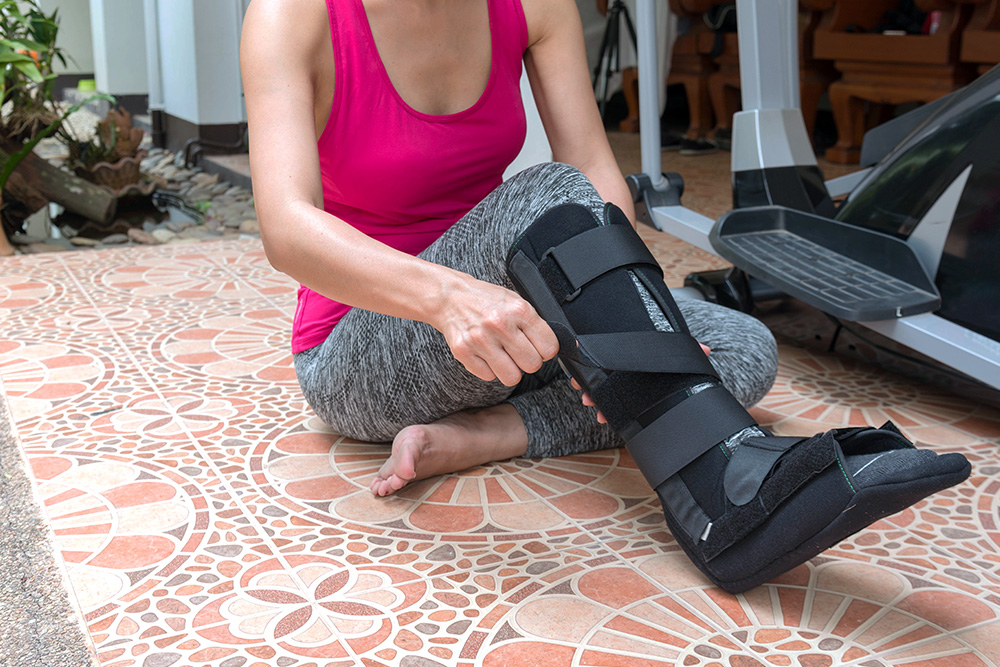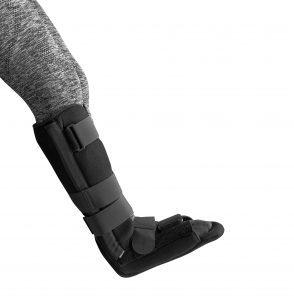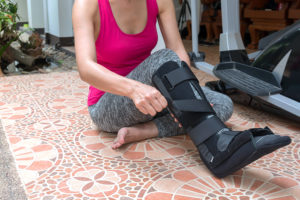
 CAM Walkers, otherwise known as Moon Boots, are an integral part of the recovery process for many patients with serious foot, ankle or lower leg injuries. They are proven to reduce your recovery from certain conditions, and after surgeries, by many weeks.
CAM Walkers, otherwise known as Moon Boots, are an integral part of the recovery process for many patients with serious foot, ankle or lower leg injuries. They are proven to reduce your recovery from certain conditions, and after surgeries, by many weeks.
Walkers are designed to optimise your recovery, helping you attain optimum and timely results. If you’ve been prescribed one of these devices by a My FootDr podiatrist, it has been done with careful consideration of all the other options – with the conclusion that this will help you best achieve your ultimate goal, the best recovery and the quickest return to everyday life.
CAM stands for Controlled Ankle Movement. It works by both keeping your foot and ankle fixed in place, and offloading (removing) some of the weight off your foot and ankle while you continue to walk. As you don’t continue to put such high amounts of pressure through the foot, it can heal more effectively.
CAM Walkers are often used as a substitute to a plaster cast because they are more durable, hygienic and easily removable. They also have ‘rocker’ soles, meaning that they are easier for you to walk in. The design of most modern walkers means that it is highly likely that you will not require crutches unless you are feeling unstable on their feet or have other conditions that may put you at risk of falls.
The benefits of a correctly clinically fitted and aligned CAM Walker are:
- Easy to take off and put on for washing your feet, changing any dressings (meaning fewer skin problems), applying ice and controlling any smell, compared to a plaster cast
- Allows you to continue walking, instead of using crutches and completely off-loading the foot and keeping it elevated as you would in a plaster cast
- The adjustable size of a walker means it can accommodate any changes in swelling as your injury heals
- Makes walking simple and easy, to get you back to work and daily living faster
- Less pain due to the weight offloading effect
- An optional Air (Pneumatic) CAM Walker can help stabilise fractures and reduce swelling
- Closed-toe and hard-shell options are also available for those returning to work
- Often, no need or vastly reduced need for crutches
Why Have I Been Given A CAM Walker?
You have a CAM Walker because you have incurred a significant injury to your foot, ankle or lower leg that requires special care and weight redistribution to help you get the best healing outcomes. It is likely that without the moon boot, continuing to walk on the foot may slow down your recovery, continue to cause you pain, or even worsen the injury.
Fractures: If you have fractured your foot or ankle, your moon boot will restrict painful & damaging foot/ankle movement and reduce the stress applied to the fractured bone during healing. It does this by taking some of the weight off the foot and ankle. Some muscular movement is still encouraged within the leg, which can reduce the length of your rehabilitation.
Ligament & Soft Tissue Injuries: If you have a ligament strain or rupture, the moon boot will prevent excessive movement of the injured ligament, preventing further strain and tearing, and can help you feel more stable on your feet (injured ligaments often cause a feeling of instability). By keeping the ligament in a controlled position with less strain, a moon boot is proven to achieve superior healing outcomes.
What Problems Can A Walker Help With?
Walkers can help with many bone, ligament and soft tissue (muscular) injuries. If it is a suitable option for you, your Podiatrist will discuss it in your appointment. We often prescribe walkers for:
- Plantar fascia tears
- Achilles tendon tears
- Bone fractures and breaks
- Severe ankle sprains
- Post-surgical offloading (weight redistribution)
- Tendon ruptures and tendonitis
Fitting Your Walker
 Before starting to use your CAM Walker, you must have it fitted by your Podiatrist to ensure the right size, fit and function. Having the right fit is absolutely essential to attaining good healing outcomes – if you borrow a walker that is the wrong fit, and it does not support your foot and leg the way it should, then you risk causing further damage and delaying your progress. Your Podiatrist will then show you how to take it on and off.
Before starting to use your CAM Walker, you must have it fitted by your Podiatrist to ensure the right size, fit and function. Having the right fit is absolutely essential to attaining good healing outcomes – if you borrow a walker that is the wrong fit, and it does not support your foot and leg the way it should, then you risk causing further damage and delaying your progress. Your Podiatrist will then show you how to take it on and off.
Putting On: Ensure your heel is sitting at the back and bottom of the liner and close it firmly. Starting from the bottom and working your way up, fastening the straps, ensuring that they are firm. Do not disrupt your walker fit & alignment by removing the inner liner.
Taking Off: Open the straps and then the liner. Slide your foot forward out of the boot. You may remove it for showering or cover it with a bag as prescribed by your My FootDr Podiatrist.
Are CAM Walkers Comfortable?
There is usually a short adjustment period while you get used to the feeling of wearing your Walker – but this isn’t necessarily uncomfortable, just a very different walking sensation. As your Walker can help reduce pain, most people quickly find it is more comfortable with the walker than without.
Beyond The Walker: Your Personalised Treatment Plan
Alongside your walker, it is likely that you will also be prescribed other treatment components to help maximise your recovery and manage your (often painful) symptoms. This may include a compression bandage, ice, pain medication, crutches, elevating the foot regularly, and rest may also be prescribed. Your CAM walker must be worn for the minimum number of weeks prescribed by your My FootDr Podiatrist.
When Should I Wear My Moon Boot?
Every injury is unique, as is the health and mobility requirements of each person. Your assessment with your Podiatrist takes into account your fracture or injury, health, medications and mobility requirements. Some fractures may require the use of the walker 24 hours per day, while others may be able to be taken off for sleeping. You must follow the advice given by your Podiatrist – this advice is provided to help you achieve the best healing outcomes in the shortest time.
Potential Risks
Your injury may increase the risk of blood clot formation (Deep Vein Thrombosis). If you feel abnormal pain or swelling in your foot or leg that does not seem related to your injury, remove the walker immediately and visit your nearest hospital or GP.
As the walker changes the way you move, please walk carefully and be cautious on slippery or uneven surfaces, and when climbing stairs. Constant, excessive weight and pressure may cause the breakdown of the boot over time. Driving with the walker is also not recommended.
The height of the walker and your altered walking style may create problems at other joints such as the knees, hips or lower back as they are not used to your new gait. The risk of these issues may be reduced by wearing a supportive & cushioned shoe with a similar heel height to the walker on your unaffected side. Your My FootDr Podiatrist will discuss this with you at your appointment.
For warmth and hygiene, you may wear a sock beneath the liner and over the compression. Do not remove the liner or any pads from the walker as these are present for a reason to help your recovery. If required, you can return for a fit adjustment – just call and make an appointment with your Podiatrist.
When To Stop Using Your CAM Walker
Before you stop using your walker, you must return to My FootDr for your discharge and post-walker rehabilitation plan. Often, an x-ray and re-examination are required to gauge if sufficient healing has occurred, and hence it is safe for you to stop using your walker. If you stop using your walker too early, you may prolong your recovery and even cause more damage to the healing area.
Cleaning & Caring For Your CAM Walker
As the liner of your walker is removable, you can safely hand wash it in warm water with a mild detergent and let it dry naturally. Do not machine wash or machine dry. Please ensure that it is completely dry before using it again. The outer component of the walker can be safely cleaned by wiping it down with mild soap and a damp cloth.
Many people also choose an odour eliminating spray for the inside of their liner between washes. With the right care, your walker can last many years and be used for multiple injuries. Please see the instructions on the liner of your walker for further care and cleaning information.


